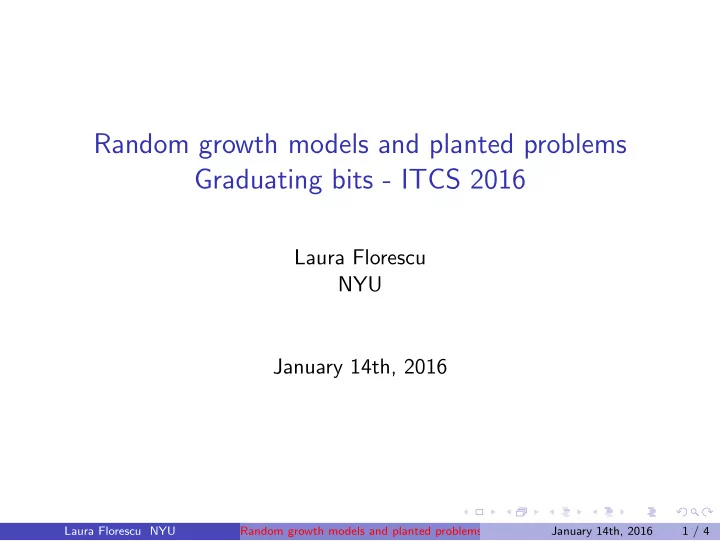

Random growth models and planted problems Graduating bits - ITCS 2016 Laura Florescu NYU January 14th, 2016 Laura Florescu NYU Random growth models and planted problems Graduating bits - ITCS 2016 January 14th, 2016 1 / 4
Bipartite Stochastic Block Model (BSBM) The stochastic block model appears in the community detection problem in networks. The BSBM has been introduced by Feldman-Perkins-Vempala in ’14 as an intermediate step in recovering solutions of planted problems such as random planted hypergraph partitioning planted k-SAT Goldreich’s planted CSP (pseudorandom generator) Figure: BSBM on V 1 and V 2 . P (red edge) = δp , P (blue edge) = (2 − δ ) p . Laura Florescu NYU Random growth models and planted problems Graduating bits - ITCS 2016 January 14th, 2016 2 / 4
Bipartite Stochastic Block Model Together with my coauthor, we show reconstruction thresholds: Theorem (F., Perkins 2016+) Let n 2 ≫ n 1 . Then there is a polynomial-time algorithm that detects the partition V 1 = A 1 ∪ B 1 if 1 + ǫ p > ( δ − 1) 2 √ n 1 n 2 for any fixed ǫ > 0 . Theorem (F., Perkins 2016+) On the other hand, if n 2 ≥ n 1 and 1 p ≤ , ( δ − 1) 2 √ n 1 n 2 then no algorithm can detect the partition. Laura Florescu NYU Random growth models and planted problems Graduating bits - ITCS 2016 January 14th, 2016 3 / 4
Rotor walks Rotor walk is the deterministic version of random walk - each site remembers its neighbors in a cyclical list and sends the particle accordingly. Together with coauthors, some of my representative results are Theorem (F., Levine, Peres 2015) For all configurations of rotors, the number of sites visited by iid rotor walk on Z d in t steps is Ω( t d/d +1 ) . Theorem (F., Levine, Peres 2015) The F- and Manhattan directed lattices are recurrent. Laura Florescu NYU Random growth models and planted problems Graduating bits - ITCS 2016 January 14th, 2016 4 / 4
Recommend
More recommend